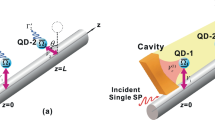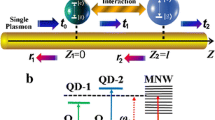Abstract
In this study, a plasmonic system coupled to a quantum dot is defined to generate the entanglement between two non-simultaneous emitted output modes. The quantum dot with three energy levels creates two different transition rates by which non-simultaneous photons are emitted. Thus, it seems that the entanglement between two emitted modes is forbidden. However, the simulation results show the entanglement between the output modes. It is because the original transition rates of the quantum dot are modified due to the lattice plasmon coupling effect. It means that the effective transition rate affected by the lattice plasmon plays a key role. The lattice plasmon coupling to quantum dot at some locations leads to a simultaneous transition by which the entanglement between output modes is established. The entangled output modes refer to the entangled photons with a specific frequency (e.g., the emission frequency). This unique behavior is theoretically discussed and the results show that using the lattice plasmon can change the transition rates by which the two emitted modes become entangled.



Similar content being viewed by others
Data and materials availability
The data generated during and/or analyzed during the current study are available from the corresponding author upon reasonable request.
References
Braunstein, S. L., Loock, P. van.: Quantum information with continuous variables. arXiv:quanta-ph/0410100v1. (2004)
Deesuwan, T.: Entanglement criteria for continuous-variable states. Master of Science of Imperial College London, London (2010)
Dominguez, D., Regan, C.J., Bernussi, A.A., Grave de Peralta, L.: Toward surface plasmon polariton quantum state tomography. J. Appl. Phys. 113, 073102–073109 (2013)
Ekert, A.K.: Quantum cryptography based on bell’s theorem. Phys. Rev. Lett. 67, 661–665 (1991)
Ge, W., Tasgin, M.E., Zubairy, M.S.: Conservation relation of nonclassicality and entanglement for Gaussian states in a beam splitter. Phys. Rev. A 92, 052328–052336 (2015)
Gerry, GCh., Eberly, J.H.: Dynamics of a Raman coupled model interacting with two quantized cavity fields. Phys. Rev. A 42, 6805–6815 (1990)
Kim, M.S., Son, W., Buzek, V., Knight, P.L.: Entanglement by a beam splitter: nonclassicality as a prerequisite for entanglement. Phys. Rev. a. 65, 032323–032330 (2002)
Laurat, J., Keller, G., Huguenin, J.A.O., Fabre, C., Coudreau, Th., Serafini, A., Adesso, G., Illuminati, F.: Entanglement of two-mode Gaussian states: characterization and experimental production and manipulation. J. Opt. B: Quantum Semiclass. Opt. 7, S577–S587 (2005)
Phillips, D.B., He, R., Chen, Q., Gibson, G.M., Padgett, M.J.: Non-diffractive computational ghost imaging. Opt. Express 13, 14172–14183 (2016)
Ross, M.B., Mirkin, Ch.A., Schatz, G.C.: Optical properties of one-, two-, and three-dimensional arrays of plasmonic nanostructures. J. Phys. Chem. C 120, 816–830 (2016)
Salmanogli, A.: Plasmonic-quantum interaction analysis with full quantum theory. Phys. Rev. A 94, 043819–043832 (2016)
Salmanogli, A.: Modification of a plasmonic nanoparticle lifetime by coupled quantum dots. Phys. Rev. A 100, 013817–013825 (2019)
Salmanogli, A.: Design of quantum sensor to duplicate European robins navigational system. Sens. Actuators, A 322, 112636–112647 (2021)
Salmanogli, A., Geçim, H.S.: Array of nanoparticles coupling with quantum-dot: lattice plasmon quantum features. Physica E 100, 54–62 (2018a)
Salmanogli, A., Geçim, H.S.: Quantum eye: lattice plasmon effect on quantum fluctuations and photon detection. Ann. Phys. 394, 162–178 (2018b)
Salmanogli, A., Gecim, H.: Optical and microcavity modes entanglement by means of developed opto-mechanical system. IEEE J. Sel. Top. Quantum Electron. 26(3), 1–10 (2020)
Salmanogli, A., Gokcen, D., Gecim, H.S.: Entanglement of optical and microcavity modes by means of an optoelectronic system. Phys Rev Appl. 11, 024075–024089 (2019)
Salmanogli, A., Gokcen, D., Gecim, H.S.: Entanglement sustainability in quantum radar. IEEE J. Sel. Top. Quantum Electron. 26, 1–11 (2020)
Salmanogli, A.: Entangled microwave photons generation using cryogenic low noise amplifier (transistor nonlinearity effects). arXiv preprint arXiv:2201.04893 (2022).
Salmanogli, A.: Squeezed states generation using cryogenic InP HEMT transistor nonlinearity. arXiv preprint arXiv: 2204.08291 (2022)
Shih, Y.: Quantum imaging. IEEE J. Sel. Top. Quantum Electron. 13, 1016–1030 (2007)
Simon, R.: Peres-Horodecki separability criterion for continuous variable system. Phys. Rev. Lett. 84, 2726–2729 (2000)
Tame, M.S., McEnery, K.R., Özdemir, ŞK., Lee, J., Maier, S.A., Kim, M.S.: Quantum plasmonics. Nat. Phys. 9, 329–340 (2013)
Waks, E., Sridharan, D.: Cavity QED treatment of interaction between a metal nanoparticles and a dipole emitter. Phys. Rev. A 82, 043845–043858 (2010)
Zou, Sh., Janel, N., Schatz, G.C.: Silver nanoparticle array structures that produce remarkably narrow plasmon lineshapes. J. Chem. Phys. 120, 10871–10875 (2004)
Funding
Not applicable.
Author information
Authors and Affiliations
Contributions
Sude Hatam contributed to the study’s conception and manuscript preparation; Ahmad Salmanogli contributed to the design, simulation, and results analysis; H. Selcuk Gecim contributed to the editing and manuscript preparation.
Corresponding author
Ethics declarations
Conflict of interest
The authors declare that they have no known competing financial interests or personal relationships that could have appeared to influence the work reported in this paper.
Ethical approval
Not applicable. There are no ethical concerns associated with this work.
Additional information
Publisher's Note
Springer Nature remains neutral with regard to jurisdictional claims in published maps and institutional affiliations.
Rights and permissions
Springer Nature or its licensor (e.g. a society or other partner) holds exclusive rights to this article under a publishing agreement with the author(s) or other rightsholder(s); author self-archiving of the accepted manuscript version of this article is solely governed by the terms of such publishing agreement and applicable law.
About this article
Cite this article
Hatem, S., Salmanogli, A. & Gecim, H.S. Quantum dot transition rate modifying by coupling to lattice plasmon. Opt Quant Electron 55, 805 (2023). https://doi.org/10.1007/s11082-023-05056-5
Received:
Accepted:
Published:
DOI: https://doi.org/10.1007/s11082-023-05056-5




